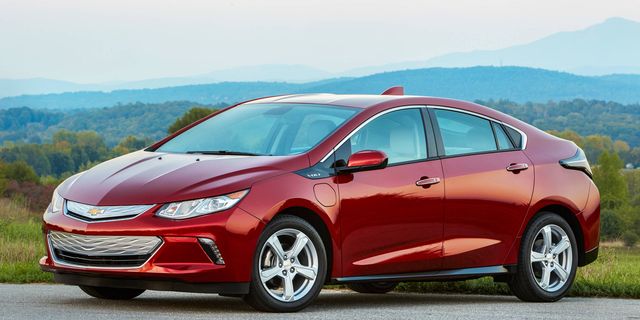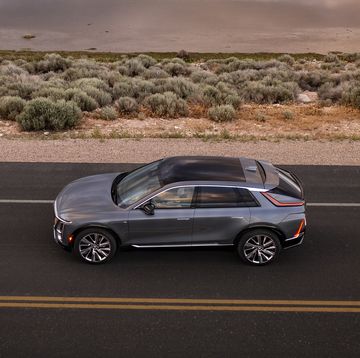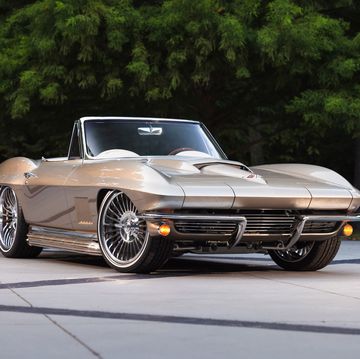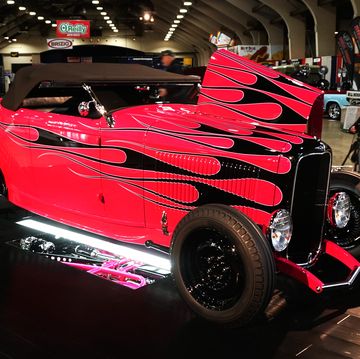For a vehicle billed as the savior of General Motors not that long ago, amid the darkest days of the recession and the automotive industry crisis, the Chevrolet Volt will be making a quiet departure amid an industry-wide turn away from sedans and toward SUVs, trucks and crossovers. GM announced last week that the Volt will exit production in 2019, along with the Chevrolet Impala, Buick LaCrosse and Cadillac CT6, signaling a major shift in long-term planning for the end of the decade and beyond. While the departure of large sedans was expected and somewhat overdue, especially as it concerns Cadillac's overlapping lineup, the planned departure of the second-generation Volt on March 1, 2019 will close a chapter that the automaker did not expect to end this way just a few years ago.
The first-generation Volt debuted in 2010 following an intense development cycle that saw GM engineers push battery technology to its limit at the time, pairing a 1.4-liter gasoline engine with a 16-kWh lithium-ion battery and wrapping the plug-in hybrid in a sleek and futuristic hatchback body. The first example rolled out of the Hamtramck plant on November 30, 2010, a year after GM negotiated a bankruptcy minefield that saw the closure of a number of brands within a relatively short period of time and had caused considerable strain on the automaker and the industry. The first-generation Volt won an impressive roster of awards in its first two years on sale, despite a high sticker price of $41,720 prior to any EV credits, and projections of unprofitability for the automaker. For overseas markets, the Volt was offered as the Opel Ampera in Europe, Buick Velite in China and Holden Volt in Australia, keeping the Chevy badge elsewhere.
The second-generation Volt debuted at the 2015 Detroit auto show amid a significantly different automotive landscape than just five years prior. The Volt went on sale as a 2016 model year vehicle with a staggered rollout that began in California and then spread to other states. It boasted a greater pure-electric range, increased energy storage and a progressive gain in mpg numbers, plus a markedly lower starting price of $33,995 before any credits and incentives.
Ultimately, the untimely demise of the Volt cannot be pinned on any one factor, but rather a significant number of fairly recognizable "usual suspects" that eroded the business case for its continued production since its launch, leading to an outcome that will no doubt continue to be studied for years to come.
1. Sales in the "recovery" years
For a vehicle billed as the GM car of the next decade, the Volt arrived amid a cratered auto sales landscape with a fairly significant sticker price, offset somewhat by a delayed tax credit. 2011 was the first full year of production, with the Volt recording 7,671 sales in the U.S. despite a fairly modest target of 10,000 units in its first year. The following model year turned out to be the high water mark for the first-gen model, with Chevrolet selling 23,461 examples of the Volt stateside. Sales dipped a little in 2013, with the Volt recording 23,094 sales in the U.S. and dropped a little more sharply in 2014 with 18,805 units sold. The final year first-gen model saw 15,393 Volts find new homes in the U.S. -- expectedly depressed by the impending promise of a new version.
Canada turned out to be the second-biggest market for the Volt, but annual sales peaked sharply at 1,521 units in 2014. For a Prius-fighter, all of these numbers were not quite what was hoped for.
The second generation experienced a peak in sales for the 2016 model year, which saw 24,739 units find new homes in the U.S. Indeed, 2016 proved to be the high water mark for the second-gen Volt as sales fell by about 4,000 units to 20,349 in 2017. Sales in 2018 are expected to reach 20,000 units.
2. Price
The Volt faced the challenge of being designed and engineered in one economic climate, to arrive on sale in a vastly different one. The impact of the economic downturn that occurred halfway through the Volt's gestation cannot be overstated -- the company barely made it out alive -- but the Volt still had to contend with a different landscape when it went on sale. It helped that new car sales favored fuel-sipping models, but the Volt's sticker price did not make it a popular alternative to something like a used Prius, or any used car for that matter. Consumers simply delayed car purchases, and even though the Volt's initial $41,725 price was cut significantly during its product cycle, it still had to compete with the more affordable Prius and a vast glut of used gas and diesel cars. By the 2018 model year, the base Volt remained $10,000 dearer than the base Prius.
3. Gasoline prices
Third, the level of oil production and gasoline prices that were predicted for the middle of the 2010s did not materialize in the U.S., thanks to a significant surge in domestic production that saw the U.S. overtake Saudi Arabia in oil production by the Volt's second generation -- a scenario that was borderline implausible a decade prior, unless one assumed that Saudi Arabia was going to run out of oil. The relatively low gas prices had a number of effects, most of which depressed the growth of EVs and hybrids as segments during this time and which persist to this day. The established players like the Prius remained and were even joined by a couple more contenders, but hybridized versions of the Chevy Tahoe were clearly not the direction that EV and hybrid fans were hoping for.
Most automakers moved to anticipate, by the end of this decade, relatively higher gasoline prices, significant advances in battery technology and a shift toward more efficient vehicles. It's debatable whether even one of these three expectations truly materialized. The Prius seemed like a particularly prescient car, and it was hard to argue with the expectation of ever-rising oil prices and a turn to renewable energy. GM and the Volt were not wrong at the time the Volt was conceived -- it was not a bad bet in 2008 -- but hybrids did not quite capture the kind of market share that was predicted to materialize by 2020. In short, there was no compelling economic force that could have forced buyers to stampede into smaller hybrids and EVs en masse.
4. The competition, hybrid and electric
Shortly after launch, the Volt faced an ever-growing number of credible and more affordable competitors, not only from hybrids but from battery-electric vehicles. The Nissan Leaf, without the advantage of a range-extending gasoline engine, eclipsed the Volt's sales during its best year of sales in 2014 by about 12,000 units. And that's for a vehicle without the benefit of a range-extending gas engine, something the Volt offered as one of its main benefits over competitors. The effect of this must have been quite demoralizing for GM planners at the time. Toyota Prius sales also remained strong with a number of offshoot models launched during the two generations of the Volt's production run.
By the Volt's second generation, it was now being squeezed from above and from below when it came to sticker price and packaging, never quite rising to the luxury territory staked out by Tesla while being too expensive to battle the Prius and a motley group of EVs closely orbiting it. The Volt's value proposition was on the economy side rather than the luxury side, and as a four-passenger hybrid it was too expensive to battle lower-priced hybrids and EVs.
5. A turn to battery-electric vehicles by GM
The PHEV formula itself is not a flawed one and is not going away anytime soon, but GM has officially announced that it will focus on pure EVs in the future, indicating that the Volt was ultimately not the right long-term direction for the automaker.
"GM now intends to prioritize future vehicle investments in its next-generation battery-electric architectures," the automaker said in announcing the demise of the Volt and a number of other vehicles. "As the current vehicle portfolio is optimized, it is expected that more than 75 percent of GM’s global sales volume will come from five vehicle architectures by early next decade."
Being a plug-in hybrid, the Volt had to pack all the hardware of a gas engine, a substantial battery and everything else to make it work. As such, it came with compromises and the complexity of really being two cars in one, while still being forced to battle hybrids and EVs in the lower price segments.
6. Slow demise of nonluxury domestic sedans
Finally, we can cite the demise of sedans as a popular segment during the Volt's two generations, especially the second one, and the concurrent and rapid growth in the popularity of crossovers and SUVs of all sizes. Simply put, the Volt was not a crossover, but it should have been. In 2010, the typical cars of 2020 looked like small hybrids and electrics with wind-cheating shapes, interiors made from renewable materials and mpg ratings well north of what the Prius offered at the time. Needless to say, most of this future did not materialize, as attested to by the rude return of mothballed Hummer H2s to the interstates by the middle of the decade, as well as the return of cheap gasoline and a market appetite for big SUVs that would look garish even by the standards of the 1990s. The economic downturn of the early 2010s has been replaced by a quicker-than-anticipated recovery -- a recovery that saw consumers flock to high-riding premium and luxury crossovers.
We are sure that there are plenty of other factors that will be mentioned in various postmortems of the Volt experiment. One of them is likely to be the frequently mentioned central tunnel running lengthwise through the cabin, reducing passenger capacity. If anything, we're a little skeptical of that being a major point of contention. First off, it sounds like more of theoretical shortcoming than an actual one -- something that dealers at competitor dealerships would point out to denigrate the Volt. After all, who regularly has to carry four (or more) passengers in their Volt? Is that a real deal-breaker for Volt buyers? "I would have bought a Volt, but since it couldn't carry one more adult in the back I'm not going to buy one because I regularly stuff my commuter car with people, even when going to the grocery story or to get a burger at a drive-thru." It just doesn't seem plausible; if you're going to buy a car to carry yourself and four passengers regularly, odds are you're not looking at a Volt to begin with because you also need luggage space for a total of five people. Yes, the tunnel was an annoying vestige of some earlier engineering decisions, but we just don't see the Volt and its competition carrying that many people regularly.
The Tesla factor is another element that we're a little skeptical of when it comes to the Volt's demise, at least when it come to sales competition. Tesla may have proved to GM that battery-electric vehicles are the way of the future, but in practical terms the Volt and various Tesla models were never direct competitors. The promised $35,000 Model 3 is still a few months away, but did Tesla Model S sales eat into Volt sales even before that? Not likely, as the S-Class-priced Model S existed in a different price segment and served different needs. If anything, the Volt was trapped between the lower-priced Prius and the higher-priced EVs in the luxury segment. But we should note that Tesla has resisted the decline in the popularity of sedans as a bodystyle, perhaps proving to GM that luxury domestic EV sedans can still make it in the marketplace even if nonluxury domestic PHEVs are facing a decline.
What other factors do you see as having contributed to the demise of the Volt?
Let us know in the comments below.

Jay Ramey grew up around very strange European cars, and instead of seeking out something reliable and comfortable for his own personal use he has been drawn to the more adventurous side of the dependability spectrum. Despite being followed around by French cars for the past decade, he has somehow been able to avoid Citroën ownership, judging them too commonplace, and is currently looking at cars from the former Czechoslovakia. Jay has been with Autoweek since 2013.












